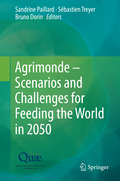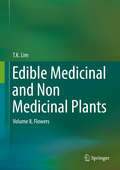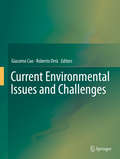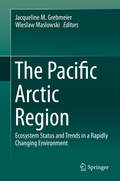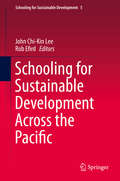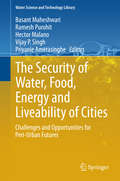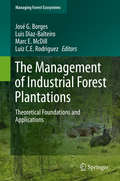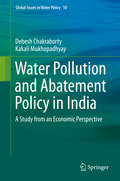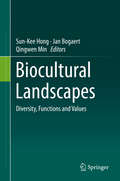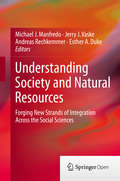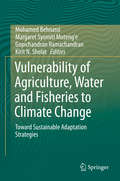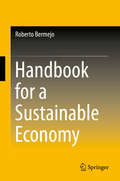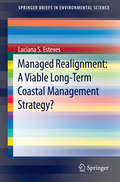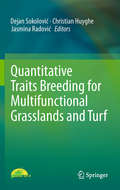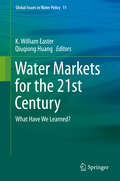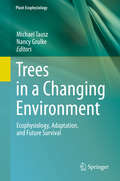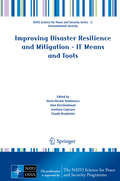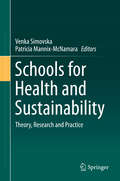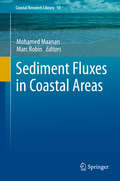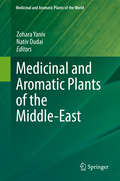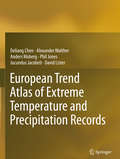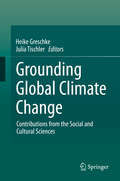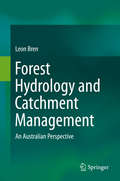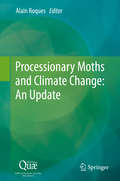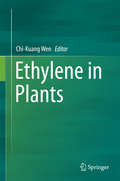- Table View
- List View
Agrimonde - Scenarios and Challenges for Feeding the World in 2050: Scenarios And Challenges For Feeding The World In 2050
by Sandrine Paillard Sébastien Treyer Bruno DorinHow will the world be able to feed close to 9 billion people in 2050 and still maintain the ecosystems? In this perspective, INRA and CIRAD launched the initiative, in 2006, to develop a foresight project for analysing issues pertaining to the world's food and agricultural systems on the 2050 timeline. This book provides a synthetic presentation of the main conclusions that this foresight project has yielded. First, it recapitulates the main statistical references for the period 1961 to 2003, before going on to describe the Agribiom simulation tool used to calculate food biomass resource use balances. Two scenarios on the 2050 timeline are then considered: Agrimonde GO is a trend-based scenario that bets on economic growth to feed the world, in a context where environmental protection is not a priority; in contrast, the idea in Agrimonde 1 is to feed the world while preserving its ecosystems.
Edible Medicinal and Non Medicinal Plants: Volume 8, Flowers
by T. K. LimVolume 8 is part of a multicompendium Edible Medicinal and Non-Medicinal Plants, on plants with edible flowers from Geraniaceae to Zingiberaceae (tabular) and 82 species in Geraniaceae, Iridaceae, Lamiaceae, Liliaceae, Limnocharitaceae, Magnoliaceae, Malvaceae, Meliaceae, Myrtaceae, Nyctaginaceae, Nymphaeaceae, Oleaceae, Onagraceae, Orchidaceae, Paeoniaceae, Papaveraceae, Plantaginaceae, Poaceae, Polygonaceae, Primulaceae, Proteaceae, Ranunculaceae, Rosaceae, Rubiaceae, Rutaceae, Solanaceae, Theaceae, Tropaeolaceae, Tyhpaceae, Violaceae, Xanthorrhoeaceae and Zingiberaceae in detail. This work is of significant interest to medical practitioners, pharmacologists, ethnobotanists, horticulturists, food nutritionists, botanists, agriculturists, conservationists and general public. Topics covered include: taxonomy; common/ vernacular names; origin/ distribution; agroecology; edible plant parts/uses; botany; nutritive/medicinal properties, nonedible uses and selected references.
Current Environmental Issues and Challenges
by Giacomo Cao Roberto OrrùFew books currently exist that cover such a wide spectrum of topics. The chapters dealing with air pollution from mobile sources, air pollution and health effects and air quality modelling fall into the air pollution category while the ones related to microalgae for carbon dioxide sequestration/biofuels production, fuel cells, and solar energy technology, respectively, can be ascribed to the energy topic. Several technologies to handle a wide spectrum of environmental pollutants are taken into account in numerous chapters. The chapter on biodiversity is clearly related to the conservation issue, while the water pollution subject is tackled by the chapter on water quality monitoring. Finally, a general analysis on green business, as well as a chapter on grid/cloud computing technology for collaborative problem solving and shared resources management conclude the work. Because of its breadth of coverage, this book is particularly useful as a graduate text.
The Pacific Arctic Region
by Jacqueline M. Grebmeier Wieslaw MaslowskiThe Pacific Arctic region is experiencing rapid sea ice retreat, seawater warming, ocean acidification and biological response. Physical and biogeochemical modeling indicates the potential for step-function changes to the overall marine ecosystem. This synthesis book was coordinated within the Pacific Arctic Group, a network of international partners working in the Pacific Arctic. Chapter topics range from atmospheric and physical sciences to chemical processing and biological response to changing environmental conditions. Physical and biogeochemical modeling results highlight the need for data collection and interdisciplinary modeling activities to track and forecast the changing ecosystem of the Pacific Arctic with climate change.
Schooling for Sustainable Development Across the Pacific
by John Chi-Kin Lee Rob EfirdEnvironmental education (EE) and education for sustainable development (ESD) are asserting their growing role in curricula around the world, yet how deeply embedded are they in the learning systems of the Pacific nations? Building on an earlier analysis in China and Taiwan, this volume expands its purview to examine the quality and extent of environmental and sustainable development education in a number of countries in the Asia-Pacific region, including China itself, Taiwan, South Korea, Japan and Indonesia As well as offering detailed national analyses provided by Asian-Pacific academics and professionals, this work includes examples in the US and Canada and an introduction that assesses the contrasting challenges and positive commonalities among diverse education systems. The chapters reflect leading-edge practice, innovation, and depth of experience and at the same time as detailing locally relevant and culturally appropriate strategies they also provide clear models and strategies for expanding the application and influence of education for sustainable development elsewhere. In doing so, they mirror the global nature of environmental issues as well as the local nature of the solutions.
The Security of Water, Food, Energy and Liveability of Cities
by Basant Maheshwari Ramesh Purohit Hector Malano Vijay P. Singh Priyanie AmerasingheThe population of cities around the world is growing at an alarming rate, and as a result the landscapes of most cities are going through enormous changes. In particular, fertile agricultural lands at the periphery of cities are being developed without consideration of holistic planning. As such, peri-urban areas, zones of transition from rural to urban land uses located between the outer limits of the urban and the rural environment are experiencing significant losses of agricultural land, increased runoff, and water quality degradation. Concurrently, the demands for water, food and energy are increasing within cities, and unless a balance is struck the liveability of these cities will soon be compromised. The current water and land use changes have serious consequences on lifestyle, environment, health and overall well-being of urban communities. This book therefore helps readers to understand the current issues and challenges and examines suitable strategies and practices to cope with current and future pressures of urbanisation and peri-urban land-use changes. The book examines a number of critical aspects in relation to the future of cities and peri-urban regions, including the suitability of policies and institutions to sustain cities into the future; impact of current trends in land use change, population increase and water demand; long term planning needs and approaches to ensure the secured future for generations ahead; and strategies to adapt the cities and land uses so that they remain viable and liveable. The readership of the book will include policy makers, urban planners, researchers, post-graduate students in urban planning and environmental and water resources management and managers in municipal councils.
The Management of Industrial Forest Plantations
by José G. Borges Luis Diaz-Balteiro Marc E. Mcdill Luiz C.E. RodriguezThe Management of Industrial Forest Plantations. Theoretical Foundations and Applications provides a synthesis of current knowledge about industrial forestry management planning processes. It covers components of the forest supply chain ranging from modelling techniques to management planning approaches and information and communication technology support. It may provide effective support to education, research and outreach activities that focus on forest industrial plantations management. It may contribute further to support forest managers when developing industrial plantations management plans. The book includes the discussion of applications in 26 Management Planning in Actions boxes. These applications highlight the linkage between theory and practice and the contribution of models, methods and management planning approaches to the efficiency and the effectiveness of industrial plantations management planning.
Water Pollution and Abatement Policy in India
by Debesh Chakraborty Kakali MukhopadhyayIndia has been traditionally well-endowed with large freshwater reserves, but increasing population, urbanization and agricultural growth in recent decades are causing overexploitation of surface and groundwater. As consumption of water grows, wastewater increases significantly and in the absence of proper measures for treatment and management, is polluting existing freshwater reserves. As a result, water pollution has emerged as one of the nation's gravest environmental threats. This book draws a link between water pollution generated by different industries and the various economic activities of the Indian economy using the Input-output framework. It constructs a detailed water pollution coefficient matrix involving different types of water pollutants. The book estimates the total amount of water pollution generated directly and indirectly in different sectors and activities, and also calculates the water pollution content in India's foreign trade sector. It also accounts for defensive expenditure from water pollution and estimates Green GDP for the extent and scope of environmental challenges. Analysis of the result indicates the variation in the pollution content of different economic activities. Finally, the book offers a portfolio of policies and assesses the implications of such policies on pollution generation in India.
Biocultural Landscapes: Diversity, Functions and Values
by Sun-Kee Hong Jan Bogaert Qingwen MinThis book is devoted to the cultural and biological dimensions and values of landscapes, linking the concepts of biodiversity, landscape and culture and presenting an essential approach for landscape analysis, interpretation and sustainable dynamics. Early chapters explore the concepts and values of biocultural landscapes, before addressing the methodology to identify the relationship between biological and cultural diversity. The volume continuous with a series of case studies and with an exploration of the key role of biocultural diversity in contemporary landscape ecology. Readers will learn the importance of landscapes for different fields of natural and human sciences and are confronted to the trans-disciplinary nature of the landscape concept itself. A hierarchical approach to landscapes, in which they are composed of interacting (eco)systems, is shown to be essential in recognizing their emergent properties. In this work, the biocultural values of landscapes are explored through their diversity in geographical scopes, methodological approaches and conceptual assumptions. Authors from Asia, Europe and North-America present diverse research experiences and views on biocultural landscapes, their pattern, conservation and management. Landscape ecologists will find this work particularly appealing, as well as anyone with an interest in sustainable landscape development, nature conservation or cultural heritage management. This volume is the outcome of a symposium on "Biodiversity in Cultural Landscapes", organized in the framework of the 8th IALE World Congress, held in Beijing in 2011.
Understanding Society and Natural Resources
by Michael J. Manfredo Jerry J. Vaske Andreas Rechkemmer Esther A. DukeIn this edited volume leading scholars from different disciplinary backgrounds wrestle with social science integration opportunities and challenges. This book explores the growing concern of how best to achieve effective integration of the social science disciplines as a means for furthering natural resource social science and environmental problem solving. The chapters provide an overview of the history, vision, advances, examples and methods that could lead to integration. The quest for integration among the social sciences is not new. Some argue that the social sciences have lagged in their advancements and contributions to society due to their inability to address integration related issues. Integration merits debate for a number of reasons. First, natural resource issues are complex and are affected by multiple proximate driving social factors. Single disciplinary studies focused at one level are unlikely to provide explanations that represent this complexity and are limited in their ability to inform policy recommendations. Complex problems are best explored across disciplines that examine social-ecological phenomenon from different scales. Second, multi-disciplinary initiatives such as those with physical and biological scientists are necessary to understand the scope of the social sciences. Too frequently there is a belief that one social scientist on a multi-disciplinary team provides adequate social science representation. Third, more complete models of human behavior will be achieved through a synthesis of diverse social science perspectives.
Vulnerability of Agriculture, Water and Fisheries to Climate Change
by Mohamed Behnassi Margaret Syomiti Muteng'E Gopichandran Ramachandran Kirit N. ShelatHuman activity is changing the global environment at an unprecedented rate while humanity faces a range of complex and interrelated challenges to local, regional and global development, human security and politics. Food security ranks high on the science, policy and development agendas. However, most research linking global change and food systems examines the impact of climate change on agricultural production, or the impact of agriculture on land use, pollution and biodiversity, overlooking interactions with other aspects of the food system - such as food processing, packaging, transportation and consumption and employment derived from these activities. This book demonstrates that new threats to food security which arise from environmental change require more than simply a focus on agricultural practices - what is needed is an integrated food system approach. The authors point out that the process of adapting food systems to global environmental change is not simply a search for technological solutions to increase agricultural yields. Tradeoffs across multiple scales among food system outcomes are a prevalent feature of globalized food systems. Within food systems, there are key underexplored areas that are both sensitive to environmental change and crucial to understanding its implications for food security and adaptation strategies. The authors assert that technical prescriptions alone will not efficiently manage the food security challenge. This book is their contribution to a new paradigm, which addresses food systems holistically by engaging researchers in multiple disciplines to understand the causes and drivers of vulnerability.
Handbook for a Sustainable Economy
by Roberto BermejoSince the 1992 World Scientists' Warning to Humanity, the looming prospect of Earth's changing climate has inspired a broad movement dedicated to a sustainable future. In this Handbook, the author explains the elements of a sustainable economy, the development of which must be undertaken if we are to retain our civilization. The first section offers a critical analysis of orthodox economical thinking, and the tools used by the conventional economy to solve the "environmental problem. " The author examines the theory and tools of Environmental Economics addressing the commodification of nature, and offers analysis of the theoretical and practical contradictions which arise from attempts to combine environmental protection and free trade. Part II discusses the principles and tools needed to build a sustainable economy, including the concept of biomimicry as a guiding principle of sustainability, a brief description of the adaptive cycle of ecosystems and explains the concept of transformability and the factors that determine it. Discussion includes a broad evaluation of the capacity for transformation of National Sustainable Development Strategies and an analysis of the essential requirements of ecology-based tax reform. Also included is a critical vision of the dominant paradigm of science and technology. The third section explores sustainable production and consumption, discussing energy, transport, the circular economy of materials and sustainable consumption. Included are a detailed analysis of factors that determine the limits of fossil fuels, a description of the peak oil structural effect and its sectoral impacts, an overview of a sustainable electric system and a review of biofuels, electricity and hydrogen. The author concludes that only hydrogen associated to fuel offers a sustainable alternative to oil. Discussion includes a view of the structural causes of the current high-level consumption model through the lens of motivation, provision and access systems and a detailed description of policies that must be adopted as part of a sustainable consumption strategy. The final chapter undertakes the task of analyzing the capability of our societies to transform themselves to reach sustainability. The author broadly evaluates each factor, as a prior step to carrying out an overall evaluation and demonstrates that in order to accomplish a comprehensive analysis, a multidisciplinary group is necessary.
Managed Realignment: A Viable Long-Term Coastal Management Strategy?
by Luciana S. EstevesManaged realignment has been a preferred coastal management strategy in England in the 21st century and has also been increasingly implemented elsewhere. Climate change and environmental and financial concerns have led to a shift from the traditional 'hold-the-line' approach of coastal protection towards more flexible soft engineering options. Managed realignment is a relatively new soft engineering alternative aiming to provide sustainable flood risk management with added environmental and socio-economic benefits by creating space for coastal habitats to develop more dynamically. The natural adaptive capacity of coastal habitats and the ecosystem services they provide underpin the sustainability of managed realignment. However, many definitions of managed realignment exist and the understanding of what the term actually represents in practice has evolved through time and varies regionally. This book clarifies the definitions and terminology used in the literature and proposes that managed realignment is used as a general term that encompasses the many different methods of implementation worldwide, including: removal, breach and realignment of defences; controlled tidal restoration (which includes regulated tidal exchange and controlled reduced tide); and managed retreat. These methods of implementation are explained and illustrated with examples from around the world. In addition to a general overview of emerging policies and current practices, specific chapters discuss approaches adopted in different locations, including the Netherlands, the UK and Maui (USA). The UK experience is presented from the perspectives of three sectors: the National Trust (a charity organisation that owns 10% of the coastline of England and Wales), the Environment Agency (the organisation responsible for implementing government policy concerning flood and erosion risk) and a private consultant involved in the planning, design and delivery of managed realignment projects. Taking a wider perspective to consider the range of implementation methods, the viability of managed realignment as a long-term coastal management strategy is discussed. Recent national and regional strategies worldwide give managed realignment an increasing role in climate change and flood risk management. Gaining stakeholders and public support is fundamental for the success of emerging coastal management strategies. However, public perception and stakeholders engagement are often cited as a factor limiting the wider uptake of managed realignment. Results from a recent survey are used to benchmark the current thinking about the potential, the performance and the limitations of managed realignment in the UK and elsewhere. Current opinions about managed realignment are often not clearly defined, partly due to many projects being relatively recent. There is a general perception of great potential to provide sustainable flood risk management with added environmental benefits. However, the views of stakeholders are considerably more negative and notably contrast with the views of practitioners and researchers. The only clear and dominant agreement across all groups of respondents is that better understanding about the long-term evolution of sites is needed
Quantitative Traits Breeding for Multifunctional Grasslands and Turf
by Dejan Sokolović Christian Huyghe Jasmina RadovićGrasslands are among the largest ecosystems in the world and consequently are of great importance to mankind. The genotypes of the species which are the main components of the grasslands have great influence on total outcome and successful utilization of grasslands. Therefore fodder crops and turf swards should be constantly improved to follow modern trends in agriculture production and landscape architecture. The wide range of breeding programs for forage and amenity species, as well as new breeding methods and techniques, is rapidly expanding the boundaries and is making it possible to achieve outstanding breeding results. This book includes papers presented at the 30th EUCARPIA Fodder Crops and Amenity Grasses Section Meeting. The challenging title of the book focuses on breeding of quantitative traits, which directly impact the profitability and sustainability of grasslands and fodder crops production, as well as on multidisciplinary approach in grassland research and utilisation. Included papers offer a unique collection of ideas and breakthroughs in the fields of fodder crops and amenity grasses breeding and genetics, as well as in the creative and innovative application of new tools in practical breeding.
Water Markets for the 21st Century
by K. William Easter Qiuqiong HuangThis book evaluates the history, the present and the future of water markets on 5 continents, beginning with the institutional underpinnings of water markets and factors influencing transaction costs. The book examines markets in seven countries and three different U. S. states, ranging from village-level water markets in Oman to basin wide formal water markets in Australia's Murray-Darling River basin. Introductory chapters on the background of water markets and on transaction costs and policy design are followed by chapter length discussion of water markets as an adaptive response to climate change and of supply reliability in a changing climate. Case studies describe a variety of facets of the design and function of markets around the world: California, Chile, Spain, Oman, Australia, Canada, India and China. In analyzing these real-world examples of markets, the contributors explore water rights and trading of rights between agricultural and urban sectors and the principles and function of option markets. They discuss different sized approaches, from large scale, ministry-level administration of markets to informal arrangements among farmers in the same village, or groups of villages which allocate water without large investment in management and infrastructure. Discussion includes questions of why water market practices have not expanded more rapidly in arid places. The book discusses mechanisms for resolving conflicts between water rights holders as well as between water right holders and third parties impacted by water trades and whether or not public ownership of water rights or use rights should trump private ownership and under what condition. Also covered are new and expanding categories of water use, beyond human consumption, agriculture and industry to new technologies ranging from extracting natural gas from shale to producing biofuels. The book concludes with suggestions for future water markets and offers a realistic picture of how they might change water use and distribution practices going forward.
Trees in a Changing Environment
by Michael Tausz Nancy GrulkeThis book delivers current state-of-the-science knowledge of tree ecophysiology, with particular emphasis on adaptation to a novel future physical and chemical environment. Unlike the focus of most books on the topic, this considers air chemistry changes (O3, NOx, and N deposition) in addition to elevated CO2 effects and its secondary effects of elevated temperature. The authors have addressed two systems essential for plant life: water handling capacity from the perspective of water transport; the coupling of xylem and phloem water potential and flow; water and nutrition uptake via likely changes in mycorrhizal relationships; control of water loss via stomata and its retention via cellular regulation; and within plant carbon dynamics from the perspective of environmental limitations to growth, allocation to defences, and changes in partitioning to respiration. The authors offer expert knowledge and insight to develop likely outcomes within the context of many unknowns. We offer this comprehensive analysis of tree responses and their capacity to respond to environmental changes to provide a better insight in understanding likelihood for survival, as well as planning for the future with long-lived, stationary organisms adapted to the past: trees.
Improving Disaster Resilience and Mitigation - IT Means and Tools
by Horia-Nicolai Teodorescu Alan Kirschenbaum Svetlana Cojocaru Claude BruderleinThe focus of this volume is comprised of the fundamentals, models, and information technologies (IT) methods and tools for disaster prediction and mitigation. A more detailed list of topics includes mathematical and computational modeling of processes leading to or producing disasters, modeling of disaster effects, IT means for disaster mitigation, including data mining tools, knowledge-based and expert systems for use in disaster circumstances, GIS-based systems for disaster prevention and mitigation and equipment for disaster-prone areas. A specific type or class of disasters (natural or human-made), however will not be part of the main focus of this work. Instead, this book was conceived to offer a comprehensive, integrative view on disasters, seeking to determine what various disasters have in common. Because disaster resilience and mitigation involve humans, societies and cultures, not only technologies and economic models, special attention was paid in this volume to gain a comprehensive view on these issues, as a foundation of the IT tool design.
Schools for Health and Sustainability
by Venka Simovska Patricia Mannix McnamaraSchools are unique places. They pay a central role in the formation of young people. The importance of how young people are educated and how they are encouraged to live and learn cannot be underestimated. This book advocates for the fostering of agency not only amongst school personnel but also amongst younger generations for health and sustainability. It provides the reader with a new lens with which to discover health promoting schools and education for sustainable development. It invites the reader to look more deeply into both and to accompany the authors on a journey of discovery of the real potential for each to enhance the practice of schooling.
Sediment Fluxes in Coastal Areas
by Mohamed Maanan Marc RobinThis book presents a detailed analysis and synthesis of the processes affecting sediments fluxes from watershed to worldwide coastal systems. The volume provides a comprehensive overview and constitutes a systematic description of the response of coastal systems to global and local changes, like climate change, sea level, land use and land cover change. The case studies cover a sequence of coastal environments such as lagoons, bays, estuaries, deltas and beaches. Sediment Fluxes in Coastal Areas is designed for researchers, professionals and for course-use in hydrology, oceanography, geography, geology, geomorphology and environmental science.
Medicinal and Aromatic Plants of the Middle-East
by Zohara Yaniv Nativ DudaiThe current volume, "Medicinal and Aromatic Plants of the Middle-East" brings together chapters on selected, unique medicinal plants of this region, known to man since biblical times. Written by leading researchers and scientists, this volume covers both domesticated crops and wild plants with great potential for cultivation. Some of these plants are well-known medicinally, such as opium poppy and khat, while others such as apharsemon and citron have both ritual and medicinal uses. All have specific and valuable uses in modern society. As such, it is an important contribution to the growing field of medicinal and aromatic plants. This volume is intended to bring the latest research to the attention of the broad range of botanists, ethnopharmacists, biochemists, plant and animal physiologists and others who will benefit from the information gathered therein. Plants know no political boundaries, and bringing specific folklore to general medical awareness can only be for the benefit of all.
European Trend Atlas of Extreme Temperature and Precipitation Records
by Deliang Chen Alexander Walther Anders Moberg Phil Jones Jucundus Jacobeit David ListerThis Atlas presents records of climatic variability and change in Europe starting before 1901 and focuses especially on trends of extreme temperatures and precipitation. The authors have used software developed within EMULATE (European and North Atlantic daily to MULtidecadal climATE variability) to obtain the extremes indices and temporal trends. The trend atlas provides an easy way to identify spatial patterns for a given time period, region, season, and index. The Atlas clearly shows that climate in Europe has changed over the last 100 to 150 years, such that the occurrence and intensity of warm temperature extremes have increased. Precipitation extremes have also changed, but with a less clear pattern compared to the temperature extremes.
Grounding Global Climate Change
by Heike Greschke Julia TischlerThis book traces the evolution of climate change research, which, long dominated by the natural sciences, now sees greater involvement with disciplines studying the socio-cultural implications of change. In their introduction, the editors chart the changing role of the social and cultural sciences, delineating three strands of research: socio-critical approaches which connect climate change to a call for cultural or systemic change; a mitigation and adaption strand which takes the physical reality of climate change as a starting point, and focuses on the concerns of climate change-affected communities and their participation in political action; and finally, culture-sensitive research which places emphasis on indigenous peoples, who contribute the least to the causes of climate change, who are affected most by its consequences, and who have the least leverage to influence a solution. Part I of the book explores interdisciplinarity, climate research and the role of the social sciences, including the concept of ecological novelty, an assessment of progress since the first Rio climate conference, and a 'global village' case study from Portugal. Part II surveys ethnographic perspectives in the search for social facts of global climate change, including climate and mobility in the West African Sahel, and human-non human interactions and climate change in the Canadian Subarctic. Part III shows how collaborative and comparative ethnographies can spin "global webs of local knowledge," describing case studies of changing seasonality in Labrador and of rising water levels in the Chesapeake Bay. These perspectives are subjected to often-amusing, always incisive analysis in a concluding chapter entitled "You Ain't Seen Nothing Yet: a death-defying look at the future of the climate debate. " The contributors engage critically with the research subject of 'climate change' itself, reflecting on their own practices of knowledge production and epistemological presuppositions. Finely detailed and sympathetic to a broad range of viewpoints, the book sets out a profile for the social sciences and humanities in the climate change field by systematically exploring methodological and theoretical challenges and approaches.
Forest Hydrology and Catchment Management
by Leon BrenFor the last three centuries forests have been recognised as providing the best water catchments and valued for their sustained output of high quality water. In Australia, work which was commenced fifty years ago has come to fruition and is providing new information on forest hydrology issues. The book focusses on the issues of small streams, including catchment definition, slope, hydrograph formation, water quality measurement, and annual water yield. The world-wide management issues of sustaining riparian forests are examined, using the River Murray forests as an example. Finally a large amount of information is drawn together to examine the management of forested catchments for water supplies. This book presents an incisive, disciplined, quantitative approach to dealing with forest hydrology matters. Although world-wide in application, the book particularly draws on Australian studies. It is written with the needs of students and forest practitioners in mind.
Processionary Moths and Climate Change: An Update
by Alain RoquesBecause of its peculiar biology, its negative impacts on forestry, and its urticating larvae affecting human and animal health, pine processionary moth has largely been studied in many European countries during the last century. However, knowledge remained scattered and no synthesis has ever been published. Since the IPCC retained the moth as one of the two insect indicators of climate change because of its expansion with warming up, filling this gap became increasingly important. Led by INRA, this book associates 101 authors from 22 countries of Europe, Minor Asia and North Africa, combining all the concerned research fields (entomology, ecology, genetics, mathematical modelling, medical and veterinary science, pest management) in a multidisciplinary approach to understand and model the processes underlying past, present and future moth expansion and to propose adapted management methods. Besides, the major biological patterns of the related processionary species are also detailed.
Ethylene in Plants
by Chi-Kuang WenThis book focuses on recent advances in our understanding of the signal transduction pathway of ethylene, its interaction with other hormones and its roles in biological processes. It discusses at which point plants could have acquired ethylene signaling from an evolutionary perspective. Ethylene was the first gaseous hormone to be identified and triggers various responses in higher plants. Our grasp of ethylene signaling has rapidly expanded over the past two decades, due in part to the isolation of the components involved in the signal transduction pathway. The book offers a helpful guide for plant scientists and graduate students in related areas.
